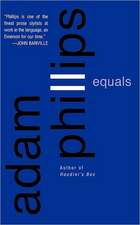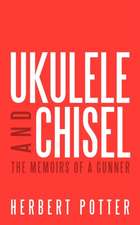Houdini's Box
Autor Adam Phillipsen Limba Engleză Paperback – 18 noi 2002
| Toate formatele și edițiile | Preț | Express |
|---|---|---|
| Paperback (2) | 68.74 lei 3-5 săpt. | +5.89 lei 7-13 zile |
| FABER & FABER – 18 noi 2002 | 68.74 lei 3-5 săpt. | +5.89 lei 7-13 zile |
| Vintage Publishing – 31 iul 2002 | 105.41 lei 3-5 săpt. |
Preț: 68.74 lei
Nou
Puncte Express: 103
Preț estimativ în valută:
13.15€ • 13.73$ • 10.89£
13.15€ • 13.73$ • 10.89£
Carte disponibilă
Livrare economică 14-28 martie
Livrare express 28 februarie-06 martie pentru 15.88 lei
Preluare comenzi: 021 569.72.76
Specificații
ISBN-13: 9780571206650
ISBN-10: 0571206654
Pagini: 176
Dimensiuni: 126 x 198 x 17 mm
Greutate: 0.14 kg
Ediția:Main. Auflage
Editura: FABER & FABER
Locul publicării:United Kingdom
ISBN-10: 0571206654
Pagini: 176
Dimensiuni: 126 x 198 x 17 mm
Greutate: 0.14 kg
Ediția:Main. Auflage
Editura: FABER & FABER
Locul publicării:United Kingdom
Notă biografică
Adam Phillips is the author of Winnicott; On Kissing, Tickling, and Being Bored; On Flirtation; Terrors and Experts; Monogamy; The Beast in the Nursery; Darwin’s Worms; and Promises, Promises. Formerly the principal child psychotherapist at Charing Cross Hospital in London, he lives in England.
Extras
Chapter One
A five-year-old girl comes into my room ready to play another round of her favorite game, hide-and-seek, a game she has been playing with me twice a week for several months. It is the way, down to the smallest detail, we always begin our time together. In the room there is an armchair, a table, and a chair. She stands in the middle of the room, closes her eyes, and says, “Start looking.”
I have watched her, as usual, walk into the room and simply close her eyes. But in her mind she is now hiding. And quite quickly getting impatient.
“Look!” she says. “Start looking!” Of course I am looking—what else could I be doing?—but I don’t seem to be playing the game. It occurs to me, for once, that perhaps I should close my eyes, which I do. And then she says a bit crossly, “OK, I’ll give you a clue. I’m not behind the chair.”
I say to her, not too plaintively, “How will I ever find you?”
“Just keep looking,” she says blithely, clearly wanting to be helpful. Then, a bit more frantic, a bit more Alice in Wonderland, “I can’t escape, I can’t escape . . . I must be here somewhere.”
“No one can look everywhere,” I say.
“We can’t escape, we’re doing that,” she replies thoughtfully, as though this was the most sensible, least histrionic of acknowledgments.
She waits, eyes squeezed shut, while I keep failing to do what it looks like I’ve already done. So what I have found—indeed can’t help seeing: her in the middle of the room, hiding—is obviously not what she wants me to look for.
“Will it be dangeroos when I find you?” I ask. (Her mother would read the sign at the zoo as “Do not feed these animals, they are dangeroos,” so “dangeroos” is her word for it.)
“You’ll die,” she replies. Then there’s a pause, and she says in her most world-weary voice, “I give up.” It is as if the rehearsal is over, and we can now resume, after another failed attempt at something, our ordinary life in the room.
There is a drama, a tableau that she has to show me, that we are both trapped in. This is what we have to take for granted, she seems to be saying, this is what we need to do together, to get things started. And the sign of our entrapment is that she never changes; whatever I say, her lines are always the same. So what I say—even though it is as different as I can make it each time, even though I rack my brains for what she wants to hear—seems equally repetitious. I am her desperate improviser, trying to spring her. I will only know if I am someone else to her if she wants to change her tune. But in this strange duet for one the hide-and-seek is like a dream game, secluded away; a play within a play that we both briefly enact and watch, and then give up on. She rarely refers to it afterwards, and I refer to it as much as I can, trying to fit it in or link it with the rest of her life. But because there is no conversation about it, because it is at once open and unopened, it is, to all intents and purposes, an unspoken thing between us.
I thought sometimes that there was a note of triumphant relief in her apparent dismay inside the game. She wants me to find her, but she warns me that I will suffer if I do; or she fears that no one really wants to find her because they wouldn’t be able to bear the consequences. Either she is practicing her privacy or there is a solitude she feels imprisoned by. The girl standing in the middle of the room with her eyes closed sometimes seems to be parading her safety, and sometimes alerting us to a terror (people often feel most alive while they are escaping, most paralyzed before and after). But either way, what is most striking about the game, when we are playing it, is that I can’t escape from looking for her, and she can’t escape from hiding. There is nowhere else for either of us to go.
This girl has been referred to me for what is called, in the strange language of what is called Social Services, “query child sexual abuse,” and truanting from home and school. So the voices of my (psychoanalytic) education provide me with a serviceable understanding of this apparently split-off game. There is something eerie about her ability to remember her lines—her knack of keeping them identical, whatever I say—but this too might be a way of managing a bewildering invasion (the violent imposition of another’s desire making her mechanical). The game might literally repeat her experience: the impossibility of being able to hide, and the wish for a magical solution to this—all you have to do is close your eyes. If I do find her she fears that I will do something terrible to her—but the terror of waiting seems more unbearable than the terror of the event—or that she might do something to me. So I might think of myself as finding words for her fears, voicing what there might be to escape from, and one way or another providing reassurances about safety. But both she and I, in her “game” and my practice, are telling each other stories about safety and danger. Indeed, what else could there be to talk about? Whether or not fear is our founding passion, we are haunted by a picture of ourselves in flight, on the run. Whether we are getting away from something or getting away with something; as Icarus or Oedipus or Narcissus, as victims or tyrants, we cannot describe ourselves without also describing what we need to escape from, and what we believe we need to escape to.
When children play hide-and-seek—or when adults are knowingly or unknowingly elusive with each other, playing at repulsion and enticement—what is being played with is the fear (and the wish) of never being found. When the game goes on too long the child who is hiding always helps the seeker out. No one must disappear for too long, no one must get too far away. And the odd moment of being found is the end of the game. But if playing hide-and-seek is one of our emblematic games—at once testing the appetite of the seeker and the resolve of the one who hides—it is also a game haunted by the possibility of escape, of being able to escape the intention, the desire of another (chosen) person. Every successful game of hide-and-seek—and one way or another, barring tragedy, it is always successful—reassures the players that no one can escape, that there is nowhere else to escape to. The transgression is to disappear, to find a place where no one keeps an eye on you. The puzzle of hide-and-seek—its absurd drama of conflicting wishes, in which to be found is to lose the game, and not being found has to be got just right—becomes a blueprint for the dilemma of the erotic, of whether we want our sexuality to intensify our self-consciousness or release us from it. In her game the little girl is convinced that neither of us can escape, that what we are doing is not escaping; that the adult is as confined as she is. What they (we) share is being trapped in something together, which might be called need or sexuality, or the wish for certain kinds of recognition and reassurance.
When I first discussed this game with her parents, they told me that when she played hide-and-seek with her friends, “she often goes so far away that she’s not really playing the game anymore.” This had made her friends very scared at first, but eventually they got used to it and “didn’t waste much time on her. . . . They don’t bother.” Beyond a certain point, after an uncertain amount of time, she has changed the game (and it is worth wondering what this particular kind of arranged solitude releases her into). And the impatience of her parents and her friends—verging on indifference, as impatience always does—seems to be an essential part of her drama, a message carefully though unconsciously sent, a reminder of the frustration that is afoot here. She makes everyone so impatient with her that they are quite unable to think exactly what it is that they are impatient for. Her not playing the game properly is not seen by her friends as a fascinating innovation; from their point of view she contributes nothing. But what do they want from her? What is assumed not to be working properly here, or indeed, in her? Like all so-called symptoms her truancy stages a dilemma for everyone involved with her. She creates a conflict inside them that they dispose of as blame and accusation. When she gets away—when the school, her friends, or her parents give up on her, that is, do the opposite of invade her—who is disappointing whom? Her behavior conjures up in people something they want to get rid of. It is not clear, when her friends just stop looking for her, who is fleeing from whom (or from what). To escape—or, of course, to be unable to escape—is often linked to a sense of failure.
Because it is apparently the preferred life one is escaping to, our fears are the key to our ideals. What we want is born of what we want to get away from. “She’s a right little Houdini,” her father told me, “she can’t wait for anything.”
A five-year-old girl comes into my room ready to play another round of her favorite game, hide-and-seek, a game she has been playing with me twice a week for several months. It is the way, down to the smallest detail, we always begin our time together. In the room there is an armchair, a table, and a chair. She stands in the middle of the room, closes her eyes, and says, “Start looking.”
I have watched her, as usual, walk into the room and simply close her eyes. But in her mind she is now hiding. And quite quickly getting impatient.
“Look!” she says. “Start looking!” Of course I am looking—what else could I be doing?—but I don’t seem to be playing the game. It occurs to me, for once, that perhaps I should close my eyes, which I do. And then she says a bit crossly, “OK, I’ll give you a clue. I’m not behind the chair.”
I say to her, not too plaintively, “How will I ever find you?”
“Just keep looking,” she says blithely, clearly wanting to be helpful. Then, a bit more frantic, a bit more Alice in Wonderland, “I can’t escape, I can’t escape . . . I must be here somewhere.”
“No one can look everywhere,” I say.
“We can’t escape, we’re doing that,” she replies thoughtfully, as though this was the most sensible, least histrionic of acknowledgments.
She waits, eyes squeezed shut, while I keep failing to do what it looks like I’ve already done. So what I have found—indeed can’t help seeing: her in the middle of the room, hiding—is obviously not what she wants me to look for.
“Will it be dangeroos when I find you?” I ask. (Her mother would read the sign at the zoo as “Do not feed these animals, they are dangeroos,” so “dangeroos” is her word for it.)
“You’ll die,” she replies. Then there’s a pause, and she says in her most world-weary voice, “I give up.” It is as if the rehearsal is over, and we can now resume, after another failed attempt at something, our ordinary life in the room.
There is a drama, a tableau that she has to show me, that we are both trapped in. This is what we have to take for granted, she seems to be saying, this is what we need to do together, to get things started. And the sign of our entrapment is that she never changes; whatever I say, her lines are always the same. So what I say—even though it is as different as I can make it each time, even though I rack my brains for what she wants to hear—seems equally repetitious. I am her desperate improviser, trying to spring her. I will only know if I am someone else to her if she wants to change her tune. But in this strange duet for one the hide-and-seek is like a dream game, secluded away; a play within a play that we both briefly enact and watch, and then give up on. She rarely refers to it afterwards, and I refer to it as much as I can, trying to fit it in or link it with the rest of her life. But because there is no conversation about it, because it is at once open and unopened, it is, to all intents and purposes, an unspoken thing between us.
I thought sometimes that there was a note of triumphant relief in her apparent dismay inside the game. She wants me to find her, but she warns me that I will suffer if I do; or she fears that no one really wants to find her because they wouldn’t be able to bear the consequences. Either she is practicing her privacy or there is a solitude she feels imprisoned by. The girl standing in the middle of the room with her eyes closed sometimes seems to be parading her safety, and sometimes alerting us to a terror (people often feel most alive while they are escaping, most paralyzed before and after). But either way, what is most striking about the game, when we are playing it, is that I can’t escape from looking for her, and she can’t escape from hiding. There is nowhere else for either of us to go.
This girl has been referred to me for what is called, in the strange language of what is called Social Services, “query child sexual abuse,” and truanting from home and school. So the voices of my (psychoanalytic) education provide me with a serviceable understanding of this apparently split-off game. There is something eerie about her ability to remember her lines—her knack of keeping them identical, whatever I say—but this too might be a way of managing a bewildering invasion (the violent imposition of another’s desire making her mechanical). The game might literally repeat her experience: the impossibility of being able to hide, and the wish for a magical solution to this—all you have to do is close your eyes. If I do find her she fears that I will do something terrible to her—but the terror of waiting seems more unbearable than the terror of the event—or that she might do something to me. So I might think of myself as finding words for her fears, voicing what there might be to escape from, and one way or another providing reassurances about safety. But both she and I, in her “game” and my practice, are telling each other stories about safety and danger. Indeed, what else could there be to talk about? Whether or not fear is our founding passion, we are haunted by a picture of ourselves in flight, on the run. Whether we are getting away from something or getting away with something; as Icarus or Oedipus or Narcissus, as victims or tyrants, we cannot describe ourselves without also describing what we need to escape from, and what we believe we need to escape to.
When children play hide-and-seek—or when adults are knowingly or unknowingly elusive with each other, playing at repulsion and enticement—what is being played with is the fear (and the wish) of never being found. When the game goes on too long the child who is hiding always helps the seeker out. No one must disappear for too long, no one must get too far away. And the odd moment of being found is the end of the game. But if playing hide-and-seek is one of our emblematic games—at once testing the appetite of the seeker and the resolve of the one who hides—it is also a game haunted by the possibility of escape, of being able to escape the intention, the desire of another (chosen) person. Every successful game of hide-and-seek—and one way or another, barring tragedy, it is always successful—reassures the players that no one can escape, that there is nowhere else to escape to. The transgression is to disappear, to find a place where no one keeps an eye on you. The puzzle of hide-and-seek—its absurd drama of conflicting wishes, in which to be found is to lose the game, and not being found has to be got just right—becomes a blueprint for the dilemma of the erotic, of whether we want our sexuality to intensify our self-consciousness or release us from it. In her game the little girl is convinced that neither of us can escape, that what we are doing is not escaping; that the adult is as confined as she is. What they (we) share is being trapped in something together, which might be called need or sexuality, or the wish for certain kinds of recognition and reassurance.
When I first discussed this game with her parents, they told me that when she played hide-and-seek with her friends, “she often goes so far away that she’s not really playing the game anymore.” This had made her friends very scared at first, but eventually they got used to it and “didn’t waste much time on her. . . . They don’t bother.” Beyond a certain point, after an uncertain amount of time, she has changed the game (and it is worth wondering what this particular kind of arranged solitude releases her into). And the impatience of her parents and her friends—verging on indifference, as impatience always does—seems to be an essential part of her drama, a message carefully though unconsciously sent, a reminder of the frustration that is afoot here. She makes everyone so impatient with her that they are quite unable to think exactly what it is that they are impatient for. Her not playing the game properly is not seen by her friends as a fascinating innovation; from their point of view she contributes nothing. But what do they want from her? What is assumed not to be working properly here, or indeed, in her? Like all so-called symptoms her truancy stages a dilemma for everyone involved with her. She creates a conflict inside them that they dispose of as blame and accusation. When she gets away—when the school, her friends, or her parents give up on her, that is, do the opposite of invade her—who is disappointing whom? Her behavior conjures up in people something they want to get rid of. It is not clear, when her friends just stop looking for her, who is fleeing from whom (or from what). To escape—or, of course, to be unable to escape—is often linked to a sense of failure.
Because it is apparently the preferred life one is escaping to, our fears are the key to our ideals. What we want is born of what we want to get away from. “She’s a right little Houdini,” her father told me, “she can’t wait for anything.”
Recenzii
“Provocative, smoothly written . . . . A pleasure to read.” —The Washington Post
“A rare achievement–as remarkable a piece of tightrope walking as Houdini ever performed himself.” --London Daily Telegraph
“Illuminating and intriguing.” --BookPage
“Fascinating.” --Entertainment Weekly
“A rare achievement–as remarkable a piece of tightrope walking as Houdini ever performed himself.” --London Daily Telegraph
“Illuminating and intriguing.” --BookPage
“Fascinating.” --Entertainment Weekly





















